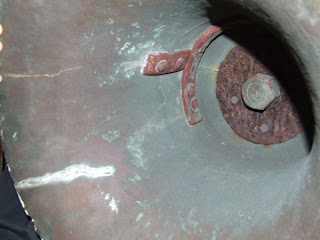1) R.H.King and J.C. Schetky's depiction of the battle, MMA M50.13.2
Our museum has several artifacts from this terrible, but iconic, battle including an officer's chest and the mess kettle from USS Chesapeake. However, the most powerful object is probably the bell of HMS Shannon. The bell is an icon of the ship and a battle that helped protect Nova Scotia from American invasion. It is also a chilling witness to the violence of the engagement. It took a direct hit in the battle and still bares the scars.
Shannon's bell is made of an unusual silver alloy and is inscribed with the classic broad arrow indicating British military property. It has the date 1740, indicating that the bell was reused from an earlier Royal Navy ship as Shannon was commissioned in 1806. Aboard Shannon the bell was housed in a belfry on the forecastle. A shot from Chesapeake early in the battle tore across the forecastle, smashed a hole in the bell, crushed the crown fitting on the head and sent cracks down its side. You can imagine what terrible things that shot did to the people on Shannon's crowded forecastle around the bell. The lethal exchange of gunnery and vicious hand to hand fighting in the battle killed 94 men and wounded 135.
3) The top of the bell showing cracks from battle and bronze rivets from repair.
The fragments of the bell were carefully preserved after the battle and transferred to the Naval Dockyard in Bermuda. The bell was repaired by fitting a plate under the crown, adding an interior brace and fixing all the fragments together with bronze rivets. In 1922, the son of the Dockyard mechanic in charge of the repair recalled,"I was often told the story by my father about the work done on the bell and results, also of the great difficulty he had in retaining the pieces, as the men around him were anxious to get them to make into rings and bracelets as souvenirs".
4) Interior detail showing the Dockyard's 19th century repair plates.
The bell was displayed in a niche at the Bermuda dockyard's clock tower. In 1952, the bell was moved from Bermuda to Halifax and was installed in the Shannon Park School in Dartmouth. It stood there as a symbol of the school and its connection to history until the Shannon Park navy base closed in 2004. The bell was transferred to the Maritme Command Museum at CFB Halifax. In a recent overhaul of our Navy Gallery we borrowed the bell as part of a long-term loan.
5) Gerry Lunn and Stephen Gillis install the bell at the Maritime Museum of the Atlantic.





Great story from The Boston Globe http://www.bostonglobe.com/ideas/2013/05/18/the-real-shameful-story-behind-don-give-ship/AVYGogGB9gtXrydeyRx1BP/story.html
ReplyDeleteGreat blog!Looking forward to more!
ReplyDeleteMarika Morris
Ottawa